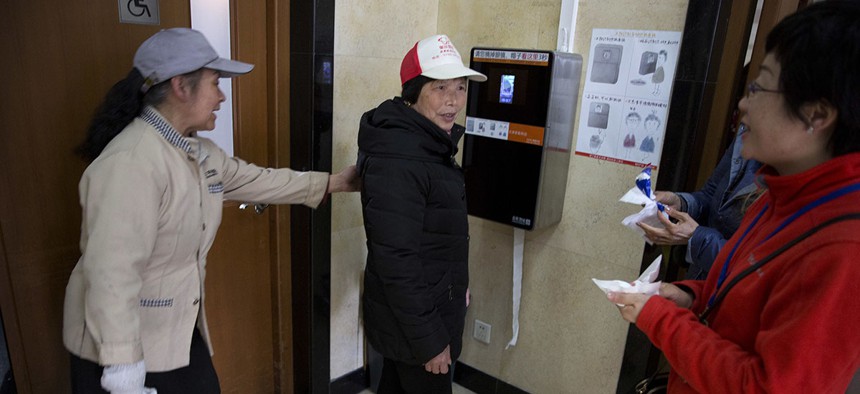In China, Facial Recognition Is Used to Buy KFC, Board Planes, and Catch Drug Users

March 21, 2017, visitors to the toilet at the Temple of Heaven park try out a facial recognition toilet paper dispenser in Beijing, China. Ng Han Guan/AP
The speed of the rollout is a sign of how China’s ambitions in artificial intelligence are advancing rapidly.
China is facing a tech boom that’s equal parts inspiring and alarming.
Over the past several months, private companies and government entities have successfully deployed facial recognition technology for a number of different purposes, ranging from shopping to public safety. The speed of the rollout is a sign of how China’s ambitions in artificial intelligence are advancing rapidly—and in a manner that will make Western techies envious, and privacy advocates queasy.
On the commercial side, dual curtain-raisings highlight how facial recognition to pay for things looks set to go mainstream in China.
Ant Financial, the financial services spinoff of e-commerce giant Alibaba, today (Sept. 1) announced it has rolled out a service with a KFC branch in Hangzhou, in eastern China, that lets customer pay for orders with their faces. It works just as one might expect—diners approach a virtual menu, select the item they want to purchase, and then choose “facial scan” as a payment option. Users must input their phone numbers as an extra layer of verification, but the technology still works even if one’s phone is turned off, an Ant Financial spokesperson tells Quartz.
A promotional video shows a young female customer scanning her face while donning a wig and appearing with friends, to tout that the technology can recognize an individual even if they are disguised or in a group.
Alibaba’s Jack Ma first introduced the technology at a tech conference in Germany in 2015, dubbing it “smile to pay.” While Ant Financial has since let users login to its Alipay mobile payments app using facial scan, the KFC partnership marks the first time it has been rolled out for commerce. An Ant Financial spokesperson tells Quartz that it intends to roll out the scanning at more locations later.
Meanwhile, on Aug. 31, news of a similar service coming from Alibaba’s arch-rival JD.com spread widely across Chinese tech blogs. According to Techweb, a customer at a JD product showroom in Beijing spotted a checkout system wherein users who have already uploaded an image of themselves to one of JD’s apps can approach a iPad, which then scans the person’s face to complete a purchase. JD declined to share more details about the technology other than stating it is in its early stage.
Yet simple commerce isn’t the only area where facial recognition technology is emerging in China. It’s quickly becoming integrated into China’s extensive surveillance apparatus. And while it indeed can be used as an effective tool to ensure safety and security, some of its use cases point toward a grim future for privacy.
On Monday, media in the northern Chinese city of Qingdao reported that police had apprehended 19 individuals at an annual beer festival who tested positive for drug use. How did they do it? Authorities simply spread 18 cameras across the premise’s four entrances and recorded the faces of more than two million attendees. Police identified individuals with past histories of drug abuse—Chinese law requires people caught using illegal drugs to register with authorities—tested them on the spot, and arrested those with positive results.
Meanwhile, in late July, authorities in Macau, which is technically a special administrative region of China with a government separate from Beijing, installed facial recognition on 680 ATMs across the city. Out-of-towners regularly travel to the casino hub to gamble and get easy access to foreign exchange, which has become increasingly difficult to do within the mainland. The facial-recognition feature only affects holders of UnionPay cards, the main payment provider in mainland China, and marks an attempt from Beijing to make it even harder to surreptitiously move capital out of its borders.
Other uses for facial recognition in China straddle the line between innovative and invasive. In Shenzhen, the city government recently introduced a device in 12 taxis that verifies the ID of a driver using facial recognition. China Southern Airlines recently introduced facial recognition instead of boarding passes, something that JetBlue is also experimenting with in the US. Beijing Normal University implemented a facial recognition system as a check-in system for one of its women’s dormitories. And an amusement park made headlines globally when it started using facial recognition to combat toilet paper theft in its restrooms.
The speed of deployment for facial recognition in China follows the country’s commitment to boosting its capabilities in artificial intelligence. In July, Beijing openly committed to making AI a “new, important” part of the economy by 2020. While overseas tech giants could implement similar technology at an equivalent speed, or much faster, public resistance will likely slow those efforts. Chinese people, on the other hand, tend to be less wary about sharing personal information online. And the Communist Party, facing no political opposition or democratic checks, can implement controversial technology with little pushback. This all means that facial recognition in China looks set to steadily move beyond few novelty cases toward near ubiquity.


